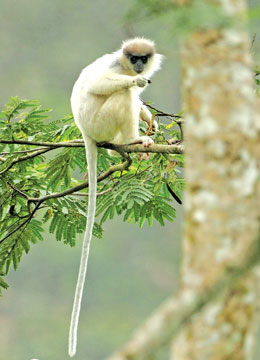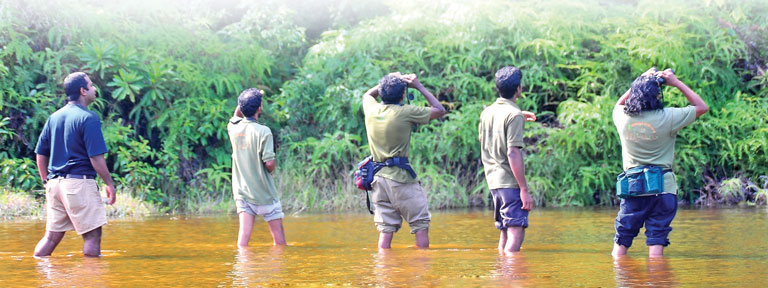Call to declare white monkeys as conservation icons
By Shanika SRIYANANDA
  Following
a 'tip off' by villagers, two toddy tappers entered Sri Lanka's virgin
forest-Sinharaja with trepidation. Clad in sarong and bare bodied they
carefully strode through the gloomy forest cover surrounded by the
Watugala village.On the third day in the village, they were able to
catch a glimpse of what they were looking for. They saw the two 'snow
balls' emerging from the dark green canopy. The images e-mailed to their
headquarters in Galle showing that their prediction of white primates
living in Sri Lanka was successful.Hidden for over 330 years from human
eyes. It was the first sighting recorded on camera. Following
a 'tip off' by villagers, two toddy tappers entered Sri Lanka's virgin
forest-Sinharaja with trepidation. Clad in sarong and bare bodied they
carefully strode through the gloomy forest cover surrounded by the
Watugala village.On the third day in the village, they were able to
catch a glimpse of what they were looking for. They saw the two 'snow
balls' emerging from the dark green canopy. The images e-mailed to their
headquarters in Galle showing that their prediction of white primates
living in Sri Lanka was successful.Hidden for over 330 years from human
eyes. It was the first sighting recorded on camera.
White monkeys are inhabitants of Sri Lanka. With evidence that the
Southern purple-faced leaf languor (Semnopithecus vetulus vetulus) are
living in Sinharaja, Wildlife Conservation Society Galle (WCSG)kicked
off its extensive survey, funded by Nations Trust Bank, in the
southwestern districts of Galle and Matara, in the wet zone.Though they
are miracles of nature, the innocent creatures face grave threat from
their predators as they are visible due to their white coat when they
are in green canopies. "They are more vulnerable than their black coated
counterparts due to the natural predators especially leopards and the
black eagle".
The two researchers - Rohan Krishantha and Sampath Gunasinghe- clad
in camouflage T-shirts and denims walked miles s in the thick forest but
failed to get any clue about the special primates. " Finally we decided
to disguise ourselves as toddy tappers in the villages. It was amazing
they didn't run away. Normally, monkeys are very intelligent, very shy
and from far away they have the capability of identifying unknown
visitors. Especially, juveniles, females carrying babies, which are very
protective, are very shy", Madhura de Silva of the WCSG said.During
their one and three-months long association with white monkeys, they
have studied about twenty-six troops (the number of white monkeys
differs in each troop) and identity numbers - T1 (Troop 1) and I1
(Individual 1) given to each white monkey according to their body
structure, special marks on the body and face and place where they were
encountered. Madura said troops were allocated a troop ID and individual
group members were numbered. " T18-I5, for example, is a white alpha
male in group T18 situated near Wathugala. The initial sighting was
followed by an intensive period of study of at least 15 days and up to
25 days, until each individual was identified and separate ID cards were
produced for each group member.
The ID cards entail a unique number and an annotated sketch with
identifiable markings. In the typical dark colour morph individuals, the
pelage characters allowed sex determination of adult individuals.
Sub-adult and infant females do not exhibit the identifiable white pubic
patch, therefore sexing of younger individuals was only possible if the
gonads were visible.
  The
white colour morph adults were also sexed using this method or
occasionally sex could be determined during mating. Age (adult,
sub-adult, infant) was estimated based on body size", he said adding
that out of 42 white monkeys observed in 26 troops, monkeys belonging to
five troops were used to make research work easy and to have close
encounters. The
white colour morph adults were also sexed using this method or
occasionally sex could be determined during mating. Age (adult,
sub-adult, infant) was estimated based on body size", he said adding
that out of 42 white monkeys observed in 26 troops, monkeys belonging to
five troops were used to make research work easy and to have close
encounters.
The WCSG research team comprising Madhura de Silva, Nadika
Hapuarachchi, Rohan Krishantha, Sampath Gunasinghe, Tharanga Aluthwala
and Sajeewa Wijeweera studied extensively and referred to literature
about the history and locations of white monkeys living in Sri Lanka.
According to recorded history in 1681, Robert Knox in his book
'Historical Relations of Ceylon' had mentioned about Sri Lanka's white
monkeys found in Ratnapura in 1653 and also E.Tent, a science writer who
was in Sri Lanka, has mentioned about them found in Ambepussa area in
his book 'Matured History of Ceylon in 1861'."According to historical
data we knew that Sri Lanka's White Monkeys are not albinos, but were a
different group.
The information given by the toddy tappers in the Watugala village
was clearly evident that these primates were inhabitants of the
Sinharaja rain forest. They are endemic to Sri Lanka and listed as
endangered in the Red List 2011 of the World Conservation Union (IUCN).
They are represented by four allopatric subspecies from different
geographical zones but in our research we focussed only on the southern
purple-faced leaf langur", Madhura said.
The researchers began collecting data from 2010 based at the Hiyare
Rainforest Reserve and their habitat was categorised as tea plantations,
home gardens, or rainforests. Madhura said in their research, the
information about white monkeys given by villagers, mainly toddy tappers,
were helpful in the planning process and they valued any knowledge about
their environment.
The newly found monkeys have white bodies and limbs, sometimes with
ashy patches, and as white tails.
Under-parts have pink and yellow skin tones visible through white
hair, and hands and feet are similarly pink and yellow toned with black
patches.
The head has white or off-white whiskers, the throat patch and hair
around the mouth are also white and the crown is beige to ashy brown
hair.
The naked parts of the face and ears are black and eyes have a golden
brown iris, as with the standard colour morph.
Madhura said there is no evidence to suggest that they were albinos
as all white individuals have a black face, none of the white
individuals have red eyes, and all the white individuals have an ashy
brown crown of hair.
" Among the Colombo National Museum primate collection a pale-coloured
specimen was collected by Phillips from the Matara District as early as
1923 and gives evidence that a slight degree of colour diversity among
the Southern purple-faced leaf languor is not uncharacteristic.
 He
said although troops - T6 to T22- were found around the protected area
of the Sinharaja Rainforest Reserve, the majority were outside the
protected regions and 73 percent of the 26 troops were recorded from the
rainforest, 19 percent were from home gardens and the remaining eight
percent were found in both- rainforest and home gardens. He
said although troops - T6 to T22- were found around the protected area
of the Sinharaja Rainforest Reserve, the majority were outside the
protected regions and 73 percent of the 26 troops were recorded from the
rainforest, 19 percent were from home gardens and the remaining eight
percent were found in both- rainforest and home gardens.
Over a quarter of the rainforest troops inhabited home ranges that
bordered tea plantations."In total, 30 individuals were recorded
displaying the newly documented white colour morph (two alpha males, 14
adults of which 13 were females, 8 sub-adults, and 5 infants).
Combinations of
a white mother and white infant and white mother with a standard
coloured infant were recorded", he explained.Madhura said they recorded
49 injuries and 33 deaths of White monkeys caused by electrocution due
to the use of power lines during road crossing.
The WCSG urges the government to take immediate action to protect the
white colour morph, which is still a rarity, and under threat of
poaching. "Only two percent of undisturbed forest remains in Sri Lanka's
wet zone, and forest cover continuously declines.
Lowland tea plantations in the south often border rainforest and
encroachment may cause further habitat loss for white monkeys.Madhura
said although the country's law protects monkeys, conserving them is not
a priority of the Departments- Forestry, Wildlife, Environment,
Agriculture, and Urban Planning.
" They will face a serious struggle to survive in future, if national
policies are not actively implemented to ensure the protection of these
species.
He said it remains vital that the Southern Province authorities
recognise the sheer economic value of high biodiversity in terms of
sustained tourism and implement strict borders and surveillance on
forest reserves such as the Sinharaja.
According to Madhura, this research is being carried out to ascertain
as to how they got white coats.
*************
Miracles in the world of nature...
-The WCSG requests the government to name the White monkeys as
conservation icons of the Sinharaja Rainforest. They said the rare
species like white lions and black bears have been declared as
conservation icons and will help to attract more visitors to their
national parks. The internationally famed success stories of
conserving the much-celebrated White Lions of Timbavarti and the
White or Spirit Bears of British Colombia became a success as they
were declared as conservation icons. “
These animals which naturally appear in the wild are considered
nothing short of miracles in the natural world and have acquired
iconic status thanks to the effort of conservationists. The public
appeal and the interest created by these white morph animals has
been very successfully used to achieve conservation victories over
commercial interests, thus preserving the natural habitat they live
in and thereby preserving a multitude of other unique forms of flora
and fauna”, Madhura said.
He said a black tiger was also found in the Sinharaja forest a
year ago but it was found dead in a nearby village later. “ We
strongly believe that there are black tigers in the forest and with
the sighting of white monkeys, we request the authorities to name
this unique primate as an icon of Sinharaja, which is a home to many
other rare gifts of nature.
************* |

